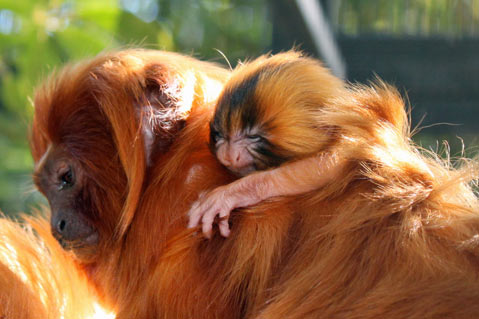Tiny Golden Lion Tamarin Monkey Born at SB Zoo

A bright orange golden lion tamarin has been born at the Santa Barbara Zoo. This is the second viable birth at the Zoo of this small endangered species of monkey from the Brazilian rainforests (called “GLTs” by keepers).
Adult GLTs weigh about 1 to 1 1/2 pounds and are roughly ten inches tall, with tails up to 15 inches long. The infant is currently about the size of a C-battery and spends most of its time clinging to its mother’s back. It appears to be in good health and will be examined by the Zoo veterinarian when it is old enough, to determine its sex, weight and other medical details. The Zoo has exhibited GLTs since 1983.
This is the second birth for a new female GLT, who arrived last year from the Potowatami Zoo (Indiana), and the Zoo’s resident male. A male offspring was born in June 2010. The golden lion tamarin family are on view in their exhibit near the Train Station. They have free access to their inside, off-exhibit area and may not be visible at all times.
“We are thrilled to be able to contribute to growing the captive population of GLTs,” said Sheri Horiszny, Director of Animal Programs. “This also gives last year’s offspring a chance to learn how to care for a newborn, which helps prepare him for future offspring of his own.”
About Golden Lion Tamarins
Golden lion tamarins were first described to the European world by the Jesuit Pigefetta, chronicler of Magellan’s voyage who described them as “beautiful simian-like cats similar to a small lion.” But they aren’t lions – they are small monkeys.
GLTs have silky, golden coats and manes around a dark face, giving the lion-like impression. They live in the forest canopy, above the forest floor, in the lowland forests of southeastern Brazil. They face huge challenges in the wild as more than 99 percent of their forest habitat has been cut down for lumber, agriculture and housing.
Adults are monogamous and share in the care of their young. Upon birth, the young climb atop their mother’s backs, leaving only to nurse. An infant does not have to leave its mothers back to nurse – her teats are almost under her arm pit, so they just slide under her arm. Both parents are involved in raising the young, who are weaned at approximately 12 weeks.
GLTs are among the most endangered mammals on earth. Deforestation and habitat loss have relegated the golden lion tamarin to a small region in eastern Brazil. In fact, almost all golden lion tamarins found in U.S. zoos, including those at the Santa Barbara Zoo, are actually considered to be on loan from the Brazilian government.
Golden lion tamarins are part of a Species Survival Plan (SSP) organized by the Association of Zoos & Aquariums in which accredited member zoos and institutions collaborate to manage the population of endangered species.
In addition, golden lion tamarins were one of the first species that zoos were able to successfully reintroduce to the wild. Captive breeding by zoos was integral to the success of the reintroduction effort. Though the Santa Barbara Zoo’s infant GLT isn’t identified to go to the wild, “this birth brings attention to their story in the wild,” adds Horiszny.
